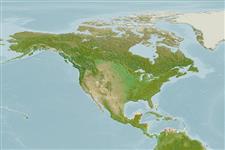>
Perciformes/Serranoidei (Groupers) >
Serranidae (Sea basses: groupers and fairy basslets)
Etymology: Hypoplectrus: Greek, hypo = under + Greek, plektron = sting, spur (Ref. 45335); ecosur: Named for the acronym of El Colegio de la Frontera Sur; noun in apposition..
Environment: milieu / climate zone / depth range / distribution range
Écologie
marin récifal; profondeur 1 - 10 m. Tropical
Western Atlantic: Mexico (known only from off Contoy, at the northern tip of the Yucatan Peninsula); but may extend into the Gulf of Mexico and Cuba.
Taille / Poids / Âge
Maturity: Lm ? range ? - ? cm
Max length : 10.0 cm SL mâle / non sexé; (Ref. 91468)
Description synthétique
Morphologie | Morphométrie
Épines dorsales (Total): 10; Rayons mous dorsaux (Total): 14-15; Épines anales 3; Rayons mous anaux: 7. This species has the usual color and patterns of the brown Barred Hamlet but with some distinguishing markings: a pair of dark rounded spots found at the base of the caudal fin, above and below the midline, usually symmetrical, present on all stages, including adults; a series of four dark brown to black spots at the upper rear body with one smaller rounded spot at the dorsal edge of the narrow mid-body bar (fourth bar), a larger oval blotch, vertically elongated at the anterior upper end of the fifth bar, a smaller flattened spot at the rear upper edge of the fifth bar below the base of the last dorsal-fin rays, and a narrow squared blotch on the upper caudal peduncle filling the space between two thin blue bars (not the full width of the sixth bar); characters not frequent on Caribbean Barred Hamlets, but associated with this species and H. floridae, include the bar under the eye being orange, even when the body bars are brown, plus a dusky pelvic fin (Ref. 91468).
Life cycle and mating behavior
Maturité | Reproduction | Frai | Œufs | Fécondité | Larves
Victor, B.C., 2012. Hypoplectrus floridae n. sp. and Hypoplectrus ecosur n. sp., two new Barred Hamlets from the Gulf of Mexico (Pisces: Serranidae): more than 3% different in COI mtDNA sequence from the Caribbean Hypoplectrus species flock. J. Ocean Sci. Found. 5:1-19. (Ref. 91468)
Statut dans la liste rouge de l'IUCN (Ref. 130435)
Menace pour l'homme
Harmless
Utilisations par l'homme
Plus d'informations
Noms communsSynonymesMétabolismePrédateursÉcotoxicologieReproductionMaturitéFraiRassemblement de ponteFéconditéŒufsDéveloppement de l'œuf
Taille/ÂgeCroissanceLongueur-poidsLongueur-longueurFréquences de longueursMorphométrieMorphologieLarvesDynamique des populations larvairesRecrutementAbondanceBRUVS
RéférencesAquacultureProfil d'aquacultureSouchesGénétiqueElectrophoresesHéritabilitéPathologiesTraitementNutrientsMass conversion
CollaborateursImagesStamps, Coins Misc.SonsCiguateraVitesseType de nageSurface branchialeOtolithesCerveauxVision
Outils
Articles particuliers
Télécharger en XML
Sources Internet
Estimates based on models
Phylogenetic diversity index (Ref.
82804): PD
50 = 0.5000 [Uniqueness, from 0.5 = low to 2.0 = high].
Bayesian length-weight: a=0.01778 (0.00680 - 0.04650), b=3.03 (2.80 - 3.26), in cm total length, based on LWR estimates for this (Sub)family-body shape (Ref.
93245).
Niveau trophique (Ref.
69278): 3.8 ±0.4 se; based on size and trophs of closest relatives
Fishing Vulnerability (Ref.
59153): Low vulnerability (10 of 100).
